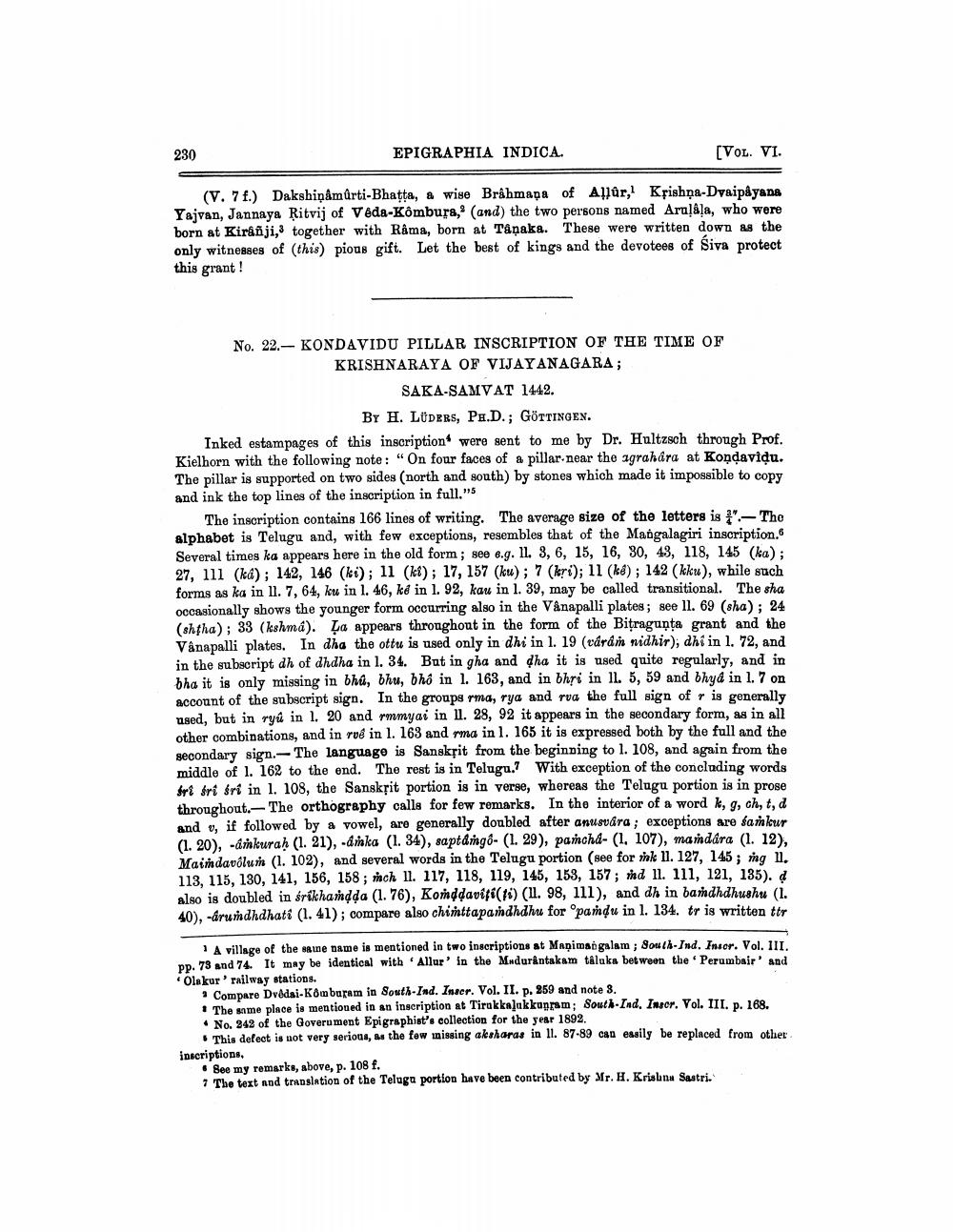________________
230
EPIGRAPHIA INDICA.
(VOL. VI.
(V. 7 f.) Dakshiņâmûrti-Bhatta, a wise Brahmapa of Asûr, Krishna-Dvaipayana Yajvan, Jannaya Ritvij of Veda-Kömbura, (and) the two persons named Araļala, who were born at Kiránji, together with Råma, born at Tänaka. These were written down as the only witnesses of (this) pious gift. Let the best of kings and the devotees of Siva protect this grant !
No. 22.- KONDAVIDU PILLAR INSCRIPTION OF THE TIME OF
KRISHNARAYA OF VIJAYANAGARA;
SAKA-SAMVAT 1442.
BY H. LUDERS, Ph.D.; GÖTTINGEN. Inked estampages of this inscriptions were sent to me by Dr. Hultzsch through Prof. Kielhorn with the following note : "On four faces of a pillar-near the agrahara at Kondavidu. The pillar is supported on two sides (north and south) by stones which made it impossible to copy and ink the top lines of the inscription in full."
The inscription contains 166 lines of writing. The average size of the letters is ". - The alphabet is Telugu and, with few exceptions, resembles that of the Mangalagiri inscription. Several times ka appears here in the old form ; see e.g. ll. 3, 6, 15, 16, 30, 43, 118. 145 (ka): 27, 111 (ka); 142, 146 (ki); 11 (kl); 17, 157 (ku); 7 (kri); 11 (ka); 142 (kku), while such forms as ka in 11. 7, 64, ku in l. 46, ké in 1. 92, kau in l. 39, may be called transitional. The sha occasionally shows the younger form occurring also in the Vanapalli plates; see 11. 69 (sha) ; 24 (shtha); 33 (kshma). Ļa appears throughout in the form of the Bițragunța grant and the Vånapalli plates. In dha the ottu is used only in dhi in l. 19 (várdi widhir), dhi in l. 72, and in the subscript dh of dhdha in l. 34. But in gha and dha it is used quite regularly, and in bha it is only missing in thú, bhu, bhô in l. 163, and in bhri in 11. 5, 59 and bhyd in 1.7 on account of the subscript sign. In the groups rma, rya and rua the full sign of r is generally used, but in ryú in l. 20 and rmmyai in ll. 28, 92 it appears in the secondary form, as in all other combinations, and in rve in l. 163 and mma in l. 165 it is expressed both by the full and the secondary sign. The language is Sanskrit from the beginning to 1. 108, and again from the middle of l. 162 to the end. The rest is in Telugu, With exception of the concluding words fri frí frí in 1. 108, the Sanskpit portion is in verse, whereas the Telugu portion is in prose throughout. The orthography calls for few remarks. In the interior of a word k, g, ch, t, d and , if followed by a vowel, are generally doubled after anusvára; exceptions are failur (1. 20), -ánkurah (1. 21), -drka (1. 34), saptaingô- (1. 29), panchd-(1, 107), mandara (1. 12), Maimdavólum (1. 102), and several words in the Telugu portion (see for ik 11. 127, 145; ing 11. 113, 115, 130, 140, 156, 158 ; tich 11. 117, 118, 109, 145, 153, 157 ; vd 11. 111, 121, 185). 4 also is doubled in sríkhandda (1.76), Konddavifi(15) (11. 98, ill), and dh in baṁdhdhushu (I. 40), -árumdhdhati (1. 41); compare also chinttapamdhdhus for opamdu in l. 134. tr is written ttr
A village of the same name is mentioned in two inscriptions at Manimangalam ; South-Ind. Inuor. Vol. III. pp. 73 and 74. It may be identical with Allur' in the Midurantakam tåluka between the Perumbair' and Olakur railway stations.
* Compare Dvdsi-Komburam in South-Ind. Inser. Vol. II. p. 259 and note 8. • The same place is mentioned in an inscription at Tirakkalakkanrsm; South-Ind. Insor. Vol. III. p. 168. • No. 342 of the Goverument Epigraphist's collection for the year 1892.
This defect is not very serious, as the fow inissing aksharas in II. 87-89 can easily be replaced from other inscriptions,
• Bee my remarks, above, p. 108 f. 7 The text and translation of the Teluga portion have been contributed by Mr. H. Krishna Sastri.




